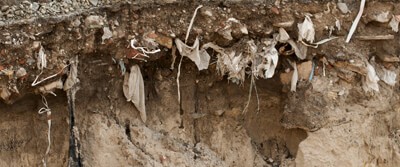Recording History in the Technosphere

By Rita Waimer
The surface of our Earth consists of layer after layer of sedimentary rock collectively known as strata. The oldest layers, including the ones where dinosaurs once roamed and are now buried, are on the bottom while the newest sit on top. These layers form slowly over time as debris and rocks pile up on sediment. The weight of all that debris, paired with heat from the Earth, turns sediment into hard rocks. Digging through the layers and examining what they’re made of can tell you a lot about what happened back then, including what the weather was like, what animals were around, and where large bodies of water formed.
For most of the Earth’s history these layers consisted of natural materials like mud, sand, stones, and even animal and plant remains. Now, however, humans are adding a new layer that consists of everything we’ve made — tools, farms, buildings, roads, trash, gadgets and much, much more. This layer is known as the technosphere.
Massive and Growing
Until recently nobody had tried to estimate the mass of the technosphere, but now Jan Zalasiewicz, a geologist at the University of Leicester in England, has done just that. Using satellite images, maps and geological knowledge, he and his team found that there are approximately 30 trillion tons of man-made stuff scattered over 31 million square miles. To put that number in perspective, it’s about 100,000 times more than the weight of all living humans.
Part of the reason there’s so much material is because it comes from all of human history, back to and even before the time of the ancient Romans. But it’s also because not very much of the technosphere gets recycled, so it continually grows. Eventually all that junk will be buried and become rock like any other layer, leaving evidence of what the Anthropocene — the current period of humans dominating the climate and environment — was like.
The incredible diversity of the technosphere will give future geologists a lot to look at. While much of it may be black carbon from food in landfills and piles of rubble from former cities, there will also be techno-fossils that help date time periods. For example, the popular iPhone 7 would clearly mark 2016 in spots all around the world, while destruction from World War II would mark the middle of the 20th century.
Discussion Questions
- In what ways have you contributed to the technosphere?
- What could we do to reduce the size of the technosphere?
- Anthropocene
- Strata
- Sediment